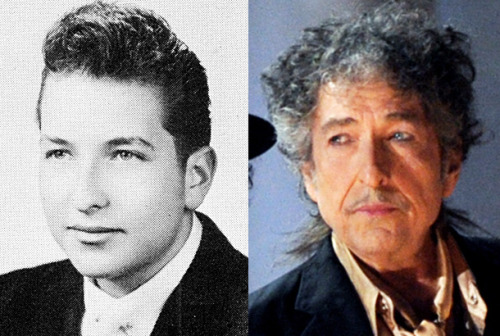
Fifty-five years ago, on January 31, 1959, Bobby Zimmerman attended a Buddy Holly performance at the Duluth National Guard Armory in Duluth, Minnesota. It was a big deal for the future Bob Dylan.
“Buddy Holly was a poet,” Dylan told journalist Robert Shelton. “Way ahead of his time.”
Shelton wrote the Dylan biography “No Direction Home: The Life and Music of Bob Dylan.”
Dylan once told Link Wray, who opened for Holly, “I was sitting in the front row when you and Buddy Holly were at Duluth…”
From what I can ascertain, Link Ray did not play at the Duluth show Dylan attended, but Dylan’s quote attests to how important seeing Holly was to him.
Bobby Zimmerman was a major Buddy Holly fan. According to Shelton, during his Senior year of high school “a new and lasting musical roll model emerged” for Dylan.
Buddy Holly.
“Bob began to imitate Holly’s sweet, naive, almost childlike voice,” Shelton wrote in “No Direction Home.” “The vocal quality of many Dylan recordings shows his debt to Holly.”
Three days after Dylan saw Holly perform, the young star, along with the Big Bopper (J. P. Richardson) and Richie Valens, died in a plane crash.
Buddy Holly has remained important to Bob Dylan. In a March 1999 interview with Guitar World Dylan spoke about Holly in relationship to the making of his 1997 album, Time Out Of Mind:
“While we were recording, every place I turned there was Buddy Holly. You know what I mean? It was one of those things. Every place you turned. You walked down a hallway and you heard Buddy Holly records like ‘That’ll Be the Day.’ Then you’d get in the car to go over to the studio and ‘Rave On’ would be playing. Then you’d walk into this studio and someone’s playing a cassette of ‘It’s So Easy.’ And this would happen day after day after day. Phrases of Buddy Holly songs would just come out of nowhere. It was spooky. (laughs) But after we recorded and left, you know, it stayed in our minds. Well, Buddy Holly’s spirit must have been someplace, hastening this record.”
Accepting a Grammy for Album of the Year for Time Out Of Mind in 1998, Dylan said:
“And I just want to say that when I was sixteen or seventeen years old, I went to see Buddy Holly play at Duluth National Guard Armory and I was three feet away from him…and he looked at me. And I just have some sort of feeling that he was — I don’t know how or why — but I know he was with us all the time we were making this record in some kind of way.”
Here’s that speech:
In 2004 Dylan told journalist Robert Hilburn, “When I got into rock ‘n’ roll, I didn’t even think I had any other option or alternative. It showed me where my future was, just like some people know they’re going to be doctors or lawyers or shortstop for the New York Yankees.”
About Buddy Holly Dylan said, “Buddy Holly’s songs were much more simplified [than Chuck Berry’s songs], but what I got out of Buddy was that you can take influences from anywhere. Like his ‘That’ll Be The Day.’ I read somewhere that it was a line he heard in a movie, and I started realizing you can take things from everyday life that you hear people say. That I still find true. You can go anywhere in daily life and have your ears open and hear something, either something someone says to you or something you hear across the room. If it has resonance you can use it in a song.”
Dylan has covered Buddy Holly songs. Below he performs Holly’s “Gotta Travel On” in 1976.
“Gotta Travel On,” The Warehouse, New Orleans, May 3, 1976 (Bob Dylan, Paul Clayton, Larry Ehrlich, Pete Seeger, Ronnie Gilbert, Lee Hays, Fred Hellerman, David Lazar, Tom Six):
Here Dylan plays “Not Fade Away” at Tramps, NYC, July 26, 1999.
And here is “Not Fade Away” performed on April 25, 1999 in Zürich, Switzerland with Nils Lofgren and Miami Steve Van Zandt:
-– A Days of the Crazy-Wild blog post: sounds, visuals and/or news –-
Michael,
Interesting post on Buddy & Bob. One thing I would question is whether Link Wray was at the show in Duluth. The backing band on that tour was Tommy Allsup (guitar); Waylon Jennings (bass); and Carl Bunch (drums). There were also a couple of horn players. The band backed up all five acts on the bill (Buddy, Ritchie Valens, the Big Bopper, Dion & the Belmonts, and Frankie Sardo). “The Day The Music Died: The Last Tour of Buddy Holly, the Big Bopper and Ritchie Valens) by Larry Lehmer is probably the definitive book on the tour and makes no mention of Link. I wonder if Bob mistook Tommy Allsup for Link.
On doing more research I think you are right. Either Dylan’s memory was wrong, or it’s part of his tendency to invent his backstory.
I included that quote of his because it placed him in the front row at that concert and showed how into Buddy Holly he was (is).
Are you sure Roger McGuinn isn’t singing on the Gotta Travel on?
He could be. I got my info here: http://www.bjorner.com/DSN03275%201976%20Rolling%20Thunder%20Revue%20II.htm#DSN03400
I wonder if Bob meant he’d seen Buddy and Wray there but at different shows? Although I know after seeing so many different shows acts can sometimes blend into the same ones.